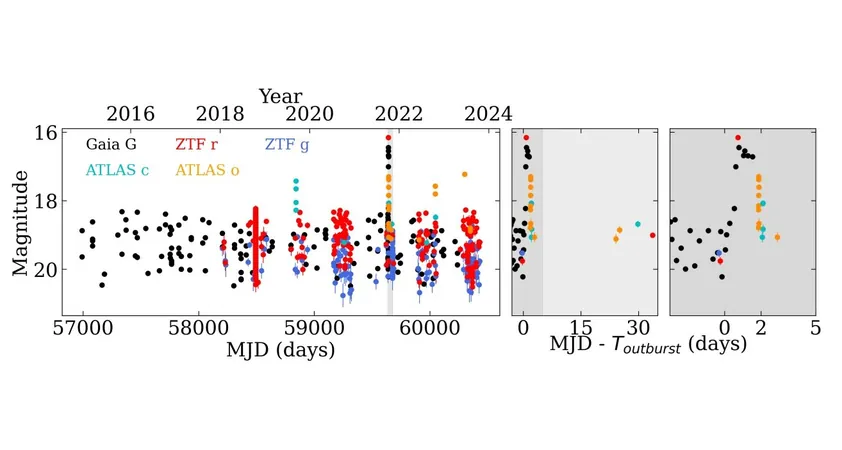
Astronomers Discover a New Class of Magnetic Accreting White Dwarf: Meet Gaia22ayj!
2025-01-13
Author: Siti
Introduction
In an exciting breakthrough in stellar astrophysics, an international team of astronomers has unveiled the unique characteristics of a variable star known as Gaia22ayj. Their findings indicate that this celestial object is a magnetic accreting white dwarf, a discovery that expands our understanding of stellar evolution and the complexities of binary star systems. The detailed results of their multiwavelength observational campaign were shared in a paper on the pre-print server arXiv on January 2, 2025.
Understanding Variable Stars and Gaia22ayj
Variable stars, particularly those in cataclysmic variable (CV) systems, play a crucial role in our understanding of stellar structures. These are binary systems composed of a white dwarf and a normal star companion, which exhibit dramatic changes in brightness, often outshining their surroundings. Gaia22ayj, located approximately 8,150 light-years from Earth, was first identified in March 2022 following an optical outburst. Recent studies have identified its rapid period of brightness changes, initially believed to represent the orbital period of the binary system.
A New Interpretation
However, lead researcher Antonio C. Rodriguez from the California Institute of Technology (Caltech) argues for a different interpretation. "Our new data suggests that the 9.36-minute period observed in Gaia22ayj is not the orbital period, but rather the spin or spin-orbit beat period of a magnetic white dwarf,” Rodriguez explains. This positions Gaia22ayj as a potential new subclass of magnetic CVs, sharing characteristics with both intermediate polars (IPs) and polars, known for their robust magnetic fields.
Observational Findings
The research team observed that Gaia22ayj pulsates at both optical and near-infrared wavelengths on the 9.36-minute cycle, demonstrating extreme brightness variations, including changes of up to 7.5–10 times within a mere 2.5 minutes. Such dramatic fluctuations point to a rich underlying physical process, most likely related to cyclotron radiation, which is typical in polar systems.
Luminous X-ray Source
Another fascinating aspect of this discovery is Gaia22ayj's status as a luminous X-ray source, with a luminosity reaching an astounding 270 nonillion erg/s in the 0.3–8 keV range. This level of brightness aligns Gaia22ayj with both the most luminous IPs and polars, intensifying its significance in the study of accreting white dwarfs. Remarkably, up to 40% linear polarization was also detected, a strong indication of its magnetic nature.
Conclusion
The researchers also noted that Gaia22ayj's outbursts are reminiscent of those seen in intermediate polars, combined with spectral signatures typical of ongoing accretion processes observed in polars. This suggests a dynamic environment where the white dwarf is actively drawing material from its companion star.
Ultimately, the findings on Gaia22ayj may represent a pivotal discovery in the field of astrophysics. The study proposes that this unique white dwarf is not just an anomaly but serves as a potential missing link between different classes of magnetic white dwarf binaries. As astronomers continue to delve into the enigmatic nature of stars like Gaia22ayj, we come closer to unraveling the mysteries of the universe and its stellar inhabitants.
Stay tuned as we explore more remarkable discoveries that promise to change our understanding of the cosmos!
 Brasil (PT)
Brasil (PT)
 Canada (EN)
Canada (EN)
 Chile (ES)
Chile (ES)
 Česko (CS)
Česko (CS)
 대한민국 (KO)
대한민국 (KO)
 España (ES)
España (ES)
 France (FR)
France (FR)
 Hong Kong (EN)
Hong Kong (EN)
 Italia (IT)
Italia (IT)
 日本 (JA)
日本 (JA)
 Magyarország (HU)
Magyarország (HU)
 Norge (NO)
Norge (NO)
 Polska (PL)
Polska (PL)
 Schweiz (DE)
Schweiz (DE)
 Singapore (EN)
Singapore (EN)
 Sverige (SV)
Sverige (SV)
 Suomi (FI)
Suomi (FI)
 Türkiye (TR)
Türkiye (TR)
 الإمارات العربية المتحدة (AR)
الإمارات العربية المتحدة (AR)